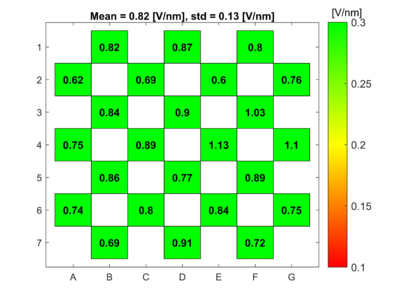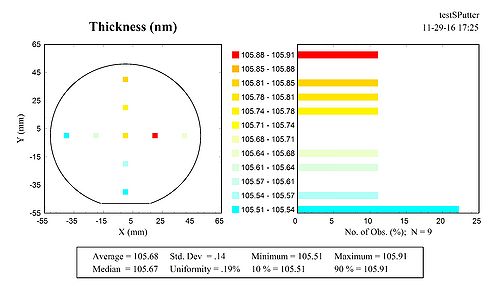Specific Process Knowledge/Thin film deposition/Deposition of Silicon Oxide/IBSD of SiO2: Difference between revisions
No edit summary |
No edit summary |
||
| (24 intermediate revisions by 3 users not shown) | |||
| Line 1: | Line 1: | ||
'''Acceptance test for SiO2 deposition | '''Feedback to this page''': '''[mailto:labadviser@nanolab.dtu.dk?Subject=Feed%20back%20from%20page%20http://labadviser.nanolab.dtu.dk/index.php/Specific_Process_Knowledge/Thin_film_deposition/Deposition_of_Silicon_Oxide/IBSD_of_SiO2 click here]''' <br> | ||
{{CC1}} | |||
[[Specific Process Knowledge/Etch/IBE⁄IBSD Ionfab 300|Go to 'IBE/IBSD Ionfab 300' equipment page]] | |||
==Acceptance test for SiO2 deposition (2011) on IBE/IBSD Ionfab 300+)== | |||
{| border="2" cellspacing="0" cellpadding="2" | {| border="2" cellspacing="0" cellpadding="2" | ||
|- | |- | ||
| Line 13: | Line 20: | ||
*50 mm SSP Si wafer | *50 mm SSP Si wafer | ||
*525 µm thick | *525 µm thick | ||
*Supplied by | *Supplied by Nanolab | ||
| | | | ||
*100 mm SSP Si wafer | *100 mm SSP Si wafer | ||
| Line 25: | Line 32: | ||
*SiO2 | *SiO2 | ||
The purpose of the SiO2 is to be part of a mirror: <br\> | The purpose of the SiO2 is to be part of a mirror: <br\> | ||
5 | 5 quarter wavelength pairs of <br\> | ||
SiO2 <br\> | SiO2 <br\> | ||
TiO2 <br\> | TiO2 <br\> | ||
Extra | Extra quarter wavelength layer of <br\> | ||
TiO2 <br\> | TiO2 <br\> | ||
5 | 5 quarter wavelength pairs of <br\> | ||
SiO2 <br\> | SiO2 <br\> | ||
TiO2 <br\> | TiO2 <br\> | ||
| Line 43: | Line 50: | ||
!style="background:silver; color:black" align="left" valign="top"|Deposition thickness | !style="background:silver; color:black" align="left" valign="top"|Deposition thickness | ||
|style="background:WhiteSmoke; color:black"| | |style="background:WhiteSmoke; color:black"| | ||
* | *222 nm | ||
| | | | ||
*~ | *~215 nm | ||
| | | | ||
*224nm | *224nm | ||
| Line 53: | Line 60: | ||
*6 nm/min | *6 nm/min | ||
| | | | ||
*7. | *7.42 nm/min +- 0.04nm/min | ||
One standard deviation | One standard deviation | ||
| | | | ||
*7. | *7.73 nm/min | ||
Only made once | Only made once | ||
|- | |- | ||
| Line 77: | Line 84: | ||
!style="background:silver; color:black" align="left" valign="top"|Stress | !style="background:silver; color:black" align="left" valign="top"|Stress | ||
|style="background:WhiteSmoke; color:black"| | |style="background:WhiteSmoke; color:black"| | ||
*< | *<500 MPa | ||
| | | | ||
*~ | *~600 MPa | ||
| | | | ||
* | *475 MPa | ||
|- | |||
!style="background:silver; color:black" align="left" valign="top"|Refractive index | |||
|style="background:WhiteSmoke; color:black"|. | |||
| | |||
*1.490+-0.004 (stddev wafer to wafer) | |||
| | |||
*1.482+-0.002 (stddev on wafer) | |||
|- | |||
|} | |||
{| border="2" cellspacing="1" cellpadding="3" align="left" | |||
! | |||
!Recipe 1 | |||
!Recipe 2 | |||
|- | |||
|Platen angle | |||
|15 degrees | |||
|10 degrees | |||
|- | |||
|Platen rotation speed | |||
|20 rpm | |||
|20 rpm | |||
|- | |||
|Ar(N) flow | |||
|4 sccm | |||
|4 sccm | |||
|- | |||
|Ar(dep. source) flow | |||
|9 sccm | |||
|8 sccm | |||
|- | |||
|I(N) | |||
|310 mA | |||
|320 mA | |||
|- | |||
|Power | |||
|675 W | |||
|700 W | |||
|- | |||
|I(B) | |||
|310 mA | |||
|280 mA | |||
|- | |||
|V(B) | |||
|1200 V | |||
|1100 V | |||
|- | |||
|Vacc(B) | |||
|400 V | |||
|400 V | |||
|- | |||
|Deposition time | |||
|29 min | |||
|37 min | |||
|- | |||
|} | |} | ||
<br clear="all" /> | |||
==Other results== | |||
===Roughness of the surface=== | |||
Measured with the Optical profiler - PSI mode (on one sample from the acceptance test): Sa= 0.6 nm | |||
===Uniformity and break down voltage ''by Mathias Engholm 2016-11-29''=== | |||
Mathias made 105.62nm SiO2 on a test silicon wafer and on his sample wafer. The sample wafer had gold/Cr on the surface and that had to be electrically isolated. The uniformity over the wafer of the oxide was 0.19% over 9 points - this is better than he has achieved when oxidizing in a furnace. He anodic bonded the wafer without problems. He measured the breakdown voltage and got 0.82+/+ 0.13 V/nm over 24 points. This is just as good as the oxide from the furnaces. Before his deposition he ran a 20 min heat up and 40min dummy deposition to clean the target. This was done with a bright new target and with the small deposition grids mounted.<br> | |||
[[File:breakdownvoltage.png|thumb|left|400px| Breakdown voltage over the wafer, ''by Mathias Engholm 2016-11-29'']] | |||
[[File:Ibsd uniformity SiO2.jpg|thumb|none|500px| Thickness uniformity over the wafer, ''by Mathias Engholm 2016-11-29'']]<br> | |||
Latest revision as of 11:56, 24 March 2023
Feedback to this page: click here
Unless otherwise stated, this page is written by DTU Nanolab internal
Go to 'IBE/IBSD Ionfab 300' equipment page
Acceptance test for SiO2 deposition (2011) on IBE/IBSD Ionfab 300+)
| . | Acceptance Criteria |
Acceptance Result 1 |
Acceptance Result 2 |
|---|---|---|---|
| Substrate information |
|
|
|
| Material to be deposited |
The purpose of the SiO2 is to be part of a mirror: <br\> 5 quarter wavelength pairs of <br\> SiO2 <br\> TiO2 <br\> Extra quarter wavelength layer of <br\> TiO2 <br\> 5 quarter wavelength pairs of <br\> SiO2 <br\> TiO2 <br\> Design wavelength (for refractive indices and layer thicknesses): 1300nm <br\> The acceptance criteria is set up for the single SiO2 and TiO2 layers. <br\> Five runs in a row for each material. |
|
|
| Deposition thickness |
|
|
|
| Deposition rate |
|
One standard deviation |
Only made once |
| Thickness uniformity |
|
|
|
| Reproducibility |
|
|
|
| Stress |
|
|
|
| Refractive index | . |
|
|
| Recipe 1 | Recipe 2 | |
|---|---|---|
| Platen angle | 15 degrees | 10 degrees |
| Platen rotation speed | 20 rpm | 20 rpm |
| Ar(N) flow | 4 sccm | 4 sccm |
| Ar(dep. source) flow | 9 sccm | 8 sccm |
| I(N) | 310 mA | 320 mA |
| Power | 675 W | 700 W |
| I(B) | 310 mA | 280 mA |
| V(B) | 1200 V | 1100 V |
| Vacc(B) | 400 V | 400 V |
| Deposition time | 29 min | 37 min |
Other results
Roughness of the surface
Measured with the Optical profiler - PSI mode (on one sample from the acceptance test): Sa= 0.6 nm
Uniformity and break down voltage by Mathias Engholm 2016-11-29
Mathias made 105.62nm SiO2 on a test silicon wafer and on his sample wafer. The sample wafer had gold/Cr on the surface and that had to be electrically isolated. The uniformity over the wafer of the oxide was 0.19% over 9 points - this is better than he has achieved when oxidizing in a furnace. He anodic bonded the wafer without problems. He measured the breakdown voltage and got 0.82+/+ 0.13 V/nm over 24 points. This is just as good as the oxide from the furnaces. Before his deposition he ran a 20 min heat up and 40min dummy deposition to clean the target. This was done with a bright new target and with the small deposition grids mounted.

